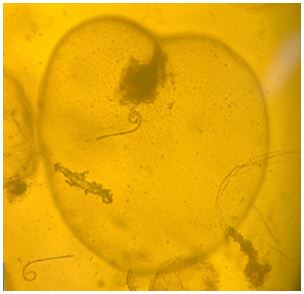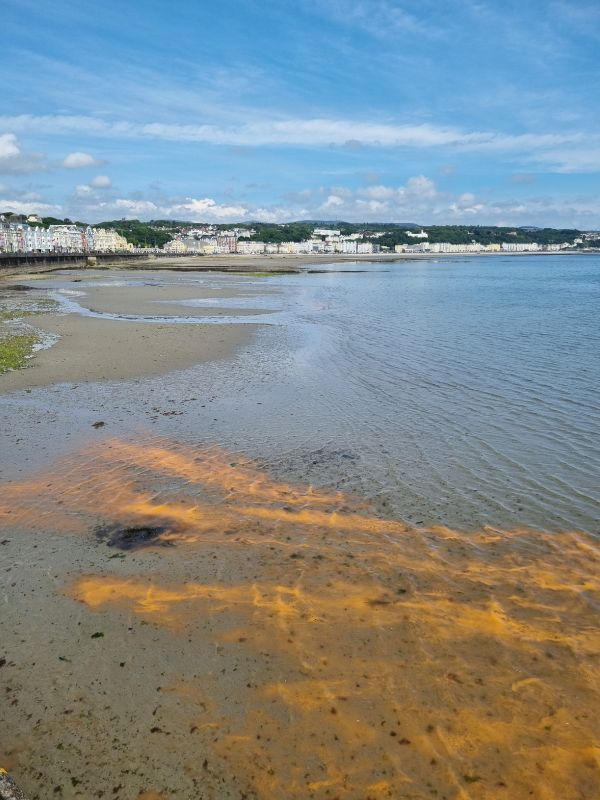Taylor Bridgens, Marine Monitoring Officer at DEFA, tells us about an orange algal bloom that happened this year in our waters:
The Isle of Man's eastern coastline recently experienced an orange algal bloom, a striking phenomenon attributed to the presence of a microscopic marine algae called Noctiluca scintillans, commonly referred to as "sea sparkle" or “fire of the sea”.
This event has drawn the attention of residents and visitors alike with its unusual orange/reddish hue in the water. The bloom was first reported on July 15th around Douglas loch promenade and was no longer visible in the area on July 17th. The Isle of Man commonly experiences “sea sparkle” on the east coast of the Island in late June and July, with reports in 2018, 2019 and 2021.
While Noctiluca scintillans is non-toxic to humans, these blooms can be classed as a harmful algal bloom under certain conditions due to potential marine impacts. Public are recommended to avoid swimming through any areas of discoloured water, although nontoxic to humans, in rare occurrences it can cause skin irritation or respiratory discomfort in sensitive individuals.
What is Sea Sparkle - Noctiluca scintillans?

Noctiluca scintillans is dinoflagellate species, a single-celled microscopic algae, that thrives in coastal waters around the world. This phytoplankton species is interesting as it does not photosynthesis, but rather feeds on other marine microscopic organisms. Additionally, Noctiluca scintillans is notable for its ability to produce bioluminescence, emitting a blue-green light when agitated by waves or movement in the water, leading to its nickname of "sea sparkle".
Noctiluca scintillans can appear orange due to the ingestion and accumulation of prey items that contain high levels of carotenoid pigments, resulting in a distinct orange and reddish hue that can discolour the water. In this orange/reddish state Noctiluca scintillans exhibits reduced bioluminescent activity.
There are numerous factors that have a compounding potential to cause an algal bloom, such as nutrient supply, light availability, and water temperature. When these factors align favourably, they can create an environment where algae can rapidly multiply, potentially leading to an algal bloom.


The July Algal Bloom observed in Douglas. Photo credit: DOI< Harbours.
Marine implications:
When large algal blooms die and begin to decompose, oxygen levels can become depleted as bacteria breaks down the dead algae, a process that consumes oxygen. In extreme cases, dissolved oxygen levels can drop below a certain threshold, to the point where aquatic life cannot survive due to low oxygen levels, this is called hypoxia.
Public recommendations:
Noctiluca scintillans observed around the Isle of Man is considered non-toxic to humans. This means that direct exposure to water is unlikely to cause harm. However, it is always advisable to avoid swimming in discolored waters to prevent skin irritation or respiratory discomfort, which can occur in sensitive individuals. Additionally, while this algae is non-toxic, these blooms can congregate other organisms, such as jellyfish, which feed on Noctiluca. The public are therefore recommended to avoid swimming through any patches of discoloured water.
Monitoring:
DEFA’s Environmental Protection Unit (EPU) collected samples on 15/07/2024 from Douglas Bay, confirming the species as Noctiluca scintillans.
In addition to monitoring bloom events, the Environmental Protection Unit conducts routine marine monitoring at the Cypris monitoring station, located roughly two nautical miles off the coast of Port Erin. This site is monitored biweekly (weather dependent) to collect phytoplankton, zooplankton, and nutrient samples, as well as collect data on various other parameters. Data collected from the Cypris monitoring station can be found on the Isle of Man Marine Monitoring webpage.


